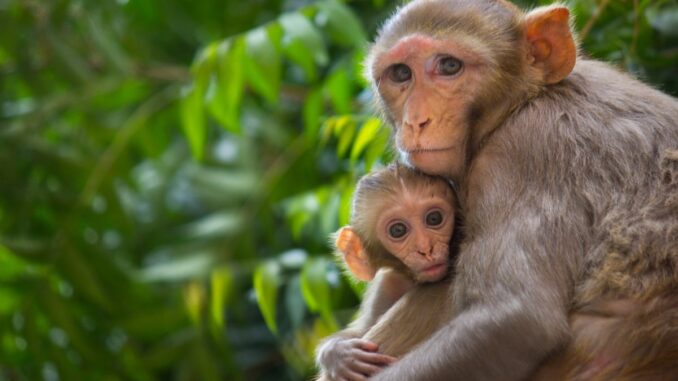
The creation of a chimeric monkey with glowing fingers and eyes is a scientific breakthrough, according to researchers in China.
The chimera was created using embryo from female crab-eating macaque and cells genetically modified to display a green glow.

BYPASS THE CENSORS
Sign up to get unfiltered news delivered straight to your inbox.
You can unsubscribe any time. By subscribing you agree to our Terms of Use
Latest Video

However, the chimeric monkey was incredibly sick and had to be put down.
Infowars has the story: Science journal Nature reported the groundbreaking birth of the unique long-tailed macaque involved injecting an embryo with genetically distinct cells:
Scientists have produced an infant ‘chimeric’ monkey by injecting a monkey embryo with stem cells from a genetically distinct donor embryo. The resulting animal is the first live-born chimeric primate to have a high proportion of cells originating from donor stem cells.
Nature reports the advancement will help future researchers who can use the chimeric monkeys as guinea pigs due to their genetic similarities to humans:
The finding, reported today in Cell, opens the door to using chimeric monkeys, which are more biologically similar to humans than are chimeric rats and mice, for studying human diseases and developing treatments, says stem-cell biologist Miguel Esteban at the University of Chinese Academy of Sciences in Guangzhou, a co-author of the study.
The chimera was created using an embryo from a female crab-eating macaque and cells genetically modified to display the green glow.
Meanwhile, the researchers extracted embryonic stem cells from one-week-old cynomolgus embryos and genetically edited the cells to display a green fluorescent signal. To grow the stem cells in the laboratory, the team finetuned the nutrients and growth-promoting proteins in the liquid in which the stem cells were grown. They then injected up to 20 green embryonic stem cells into each of the recipient embryos, yielding 74 chimeric embryos with a strong fluorescent signal.
The embryos were then implanted into surrogate female monkeys.
These embryos were implanted into 40 surrogate female monkeys. Just 12 surrogates became pregnant, and only one gave birth to a live chimeric monkey, a male that was later euthanized.
Unfortunately, the chimeric monkey was incredibly sick and later had to be put down.
But the monkey chimaera had to be euthanized when it was only ten days old because of hypothermia and breathing difficulties, highlighting the need for further optimization of the approach and raising ethical concerns, say researchers.
The monkey’s condition indicates the donor cells may not have been a correct match:
The low birth rate of chimeric monkeys and the poor health of the one survivor suggest that the donor embryonic stem cells did not perfectly match the developmental state of the recipient embryo, says reproductive biologist Zhen Liu at the Chinese Academy of Sciences in Shanghai. The team plans to optimize this in future, he adds.
While scientists playing God sounds incredibly terrifying, researchers say the procedure “might be used to grow human organs in pig or non-human primate tissues.”
“If we can delete the genes encoding for, say, the kidney, in a large animal such as a pig or primate, we could introduce human cells to produce that organ instead,” explained Shoukhrat Mitalipov, the director of the Oregon Health & Science University Center for Embryonic Cell and Gene Therapy.
Sure — let us know when you have a chimeric monkey that can live longer than 10 days.


